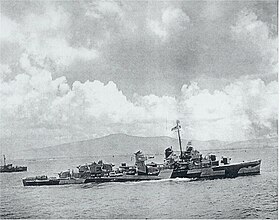USS Norman Scott (DD-690)
 USS Norman Scott landing on Saipan in June 1944 |
|
| Overview | |
|---|---|
| Type | destroyer |
| Shipyard | |
| Keel laying | April 26, 1943 |
| Launch | August 28, 1943 |
| 1. Period of service |
|
| period of service |
November 5, 1943-30. April 1946 |
| Whereabouts | Sold for demolition on December 3, 1973 |
| Technical specifications | |
| displacement |
2,050 ts |
| length |
114.7 meters |
| width |
12.2 meters |
| Draft |
5.4 meters |
| crew |
329 |
| drive |
|
| speed |
35 knots |
| Range |
6,500 nautical miles (11,700 km) at 15 knots |
| Armament |
|
The USS Norman Scott (DD-690) was a destroyer in the US Navy and belonged to the Fletcher class . She took part in World War II . In 1973 it was sold for demolition.
Namesake
Rear Admiral Norman Scott (1889–1942) was an officer in the United States Navy. He was killed in the sinking of the light cruiser USS Atlanta during the Battle of Guadalcanal . Posthumously he was awarded the Medal of Honor . Scott was one of two American admirals who died in surface skirmishes during World War II.
technology
Hull and drive
The hull of the USS Norman Scott was 114.7 m long and 12.2 m wide. The draft was 5.4 m, the displacement was 2,050 tons . The ship was powered by two General Electric steam turbines, and the steam was generated in four Babcock & Wilcox boilers. The power was 60,000 shaft horsepower, the top speed was 35 knots .
Armament and Electronics
The main armament of the USS Norman Scott when it was commissioned was its five 5-inch / 127-mm Mark 30 individual turrets. In addition, there were various anti-aircraft guns , which were reinforced in the course of the war.
The USS Norman Scott was equipped with radar . An SG and an SC radar were mounted on the mast above the bridge, with which aircraft could be located at distances between 15 and 30 nautical miles and ships between 10 and 22 nautical miles.
history
The USS Norman Scott was laid down at Bath Iron Works on April 26, 1943 and launched on August 28, 1943. Godmother was Mrs. Norman Scott. On November 5, 1943, the ship was put into service under the command of Commander Seymour D. Owens.
1944
On January 14, 1944, the USS Norman Scott left Boston and escorted USS Canberra to Pearl Harbor , where it entered on February 1, 1944. Then the destroyer took part in the Battle of the Marshall Islands and accompanied the USS Gambier Bay to Majuro . USS Norman Scott returned to Pearl Harbor and was equipped there for the Battle of the Mariana Islands . During the mission, it protected the heavy units when bombarding coastal positions. During the Battle of Saipan on June 15 and the landing on Tinian , the destroyer used its artillery against Japanese positions. On July 24, the battleship USS Colorado was shelled by coastal batteries off Tinian. While drawing fire from the USS Colorado's coastal battery , the USS Norman Scott was hit six times in a matter of seconds. The commander Cdr. Seymor Owens and 22 other crew members fell and 57 men were wounded. The ship was temporarily repaired on Saipan. On July 28, the destroyer set course for Pearl Harbor and then to the Mare Island Naval Shipyard , where repairs were completed on October 21. USS Norman Scott was the focus of the October 1944 film This is America-Navy Yard , which included the repair work. On October 21, 1944, she left Mare Island to rejoin her sister ships in Destroyer Squadron (DesRon) 54 .
1945
The USS Norman Scott conducted training with its new crew in Hawaiian waters and then went to Manus. She escorted vans to the Philippines until February 9th . She then belonged to the aircraft carrier task forces of the 5th and 3rd Fleet, which carried out air strikes during the Battle of Iwojima and the Battle of Okinawa . On July 15, the USS Norman Scott accompanied the battleships USS Iowa , USS Missouri and USS Wisconsin as well as the destroyers USS Remey and USS McGowan in the attack on the port of Muroran , the first bombardment of the Japanese heartland by surface units.
post war period
After occupying the Japanese naval base in Yokosuka , the USS Norman Scott returned briefly to Okinawa and then set course for the west coast of the United States. She reached Tacoma , Washington on October 27, 1945 . In San Francisco she was decommissioned on April 30, 1946 and was then part of the reserve fleet in San Diego . In 1947 she moved to Mare Island.
Whereabouts
The USS Norman Scott was removed from the fleet list on April 15, 1973 and sold for demolition on December 3, 1973.
Awards
The USS Norman Scott was awarded seven Battle Stars .
literature
- Jerry Scutts: Fletcher DDs (US Destroyers) in action (Warships No. 8) . Squadron / signal publications, Carrollton (Texas) 1995, ISBN 0897473361
- Theodore Roscoe: Destroyer Operations in World War II . United States Naval Institute, Annapolis, 1953, ISBN 978-0-87021-726-5
Web links
- History of USS Norman Scott (DD-690) in the Dictionary of American Naval Fighting Ships (English)
- navsource.org: USS Taylor (English)
- hazegray.org: USS Taylor (English)